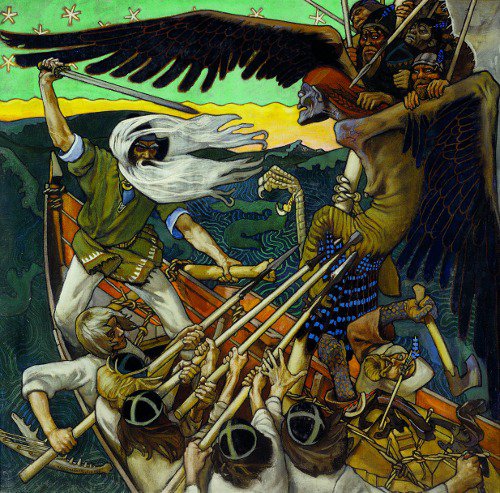Akseli Gallen-Kallela (1865-1931)
dal 1/6/2012 al 8/9/2012
Segnalato da
1/6/2012
Akseli Gallen-Kallela (1865-1931)
Museum Kunstpalast, Dusseldorf
Finland and the Modernist Spirit. A major exhibition dedicated to this eminent 19th-century northern European artist. It comprises around 70 paintings - portraits, interiors, landscapes, everyday scenes, mythological depictions of heroes - a number of textile and furniture designs and objects, as well as graphic art spanning 5 decades.

curated by Barbara Til
In collaboration with the Musée d'Orsay in Paris and the Helsinki Art Museum, Museum
Kunstpalast in Düsseldorf will be showing, from 2 June – 9 September 2012, a survey
exhibition of one of the most important northern European and the most eminent 19th-
century Finnish artist: Axel Gallen, who in 1907 changed his name to Akseli Gallen-Kallela
(1865-1931).
The exhibition, curated in Düsseldorf by Barbara Til, Deputy Head of the Collection and
curator for applied art at Museum Kunstpalast, comprises around 70 paintings – portraits,
interiors, landscapes, everyday scenes, mythological depictions of heroes -, a number of
textile and furniture designs and objects, as well as graphic art spanning five decades.
From the 1880s onwards Akseli Gallen-Kallela was among the leading artists of early
Modernism in Finland. Even though he was firmly rooted in his native country, he was a
convinced cosmopolitan who was in close contact with the European art scene. In the
1880s he initially studied with William Bougereau and Tony Robert-Fleury at the
Académie Julian in Paris, and subsequently continued his studies in the studio of Fernand
Cormon. In the mid 1890s he worked in Germany, where he had an exhibition in Berlin
jointly with Edvard Munch and was commissioned with illustrations for the first edition of
the art magazine “Pan” published in 1895.
Gallen-Kallela gained international renown through his work on the Finnish Pavilion at the
World’s Fair in Paris in 1900, where he painted ceiling frescoes and designed the Iris
Room. In 1902 he worked together with Wassily Kandinsky, and in the same year he
contributed 18 works to an exhibition of Nordic art in Krefeld, Germany. In 1901 and 1904
he took part in the exhibitions of the Vienna Secession. In March 1907 he accepted an
invitation by Erich Heckel to join the artists’ association “Brücke”, of which he was a
member until 1909.
Although initially the works of Gallen-Kallela were strongly influenced by French
Naturalism, his reflections upon the Finnish national epic Kalevala later became
particularly evident in his art. By exploring symbolism and synthetism in the subsequent
years, Gallen-Kallela succeeded in perfecting his style, which eventually fully unfolded in
his large Kalevala-inspired compositions.
The epic Kalevala, Finnish incantations passed on originally by oral tradition, was
compiled in written form for the first time by Elias Lönnrot and published in 1835.
Towards the late 19th century the epic, comprising more than 20,000 verses, increasingly
became an important symbol in the ideological struggle for a national Finnish identity. For
Gallen-Kallela, who as member of the artists’ movement Nuori Suomi (Young Finland)
pleaded for Finland’s cultural independence from Russia, the epic offered a rich
inspirational source for artistic representations of Finnish heroic tales. It was thus not
only the Finnish landscape, but also the Kalevala from which he drew his most significant
and important pictorial themes.
Akseli Gallen-Kallela is regarded as one of the versatile “universal artists” of the late 19th
and early 20th century. In 1894/95, the studio house Kallela at lake Ruovesi was built from
his plans using traditional construction techniques. Likewise, the wooden house’s entire
interior, including its furniture in Finnish art nouveau style, was designed by the artist
himself. Aside from his graphic work, his craftsmanship, as well as his architectural and
literary oeuvre, it was, however, the field of painting which always remained the main
focus of his artistic pursuits.
A particular repertoire of motifs is reflected in the paintings made by Gallen-Kallela in
1909 during his 18-month stay in British East Africa (Kenya). In this wealth of small-scale
expressionist-style paintings he directed his attention to the landscape, people and fauna
of Africa.
Gallen-Kallela not only temporarily devoted his art to the Finnish national movement, but
in 1918 also took part in the Finnish civil war jointly with his son Jorma. Following a
number of journeys to the USA and an extended, several-month stay at the popular
artists’ venue Taos in New Mexico, he returned to Helsinki in the late 1920s. Here, in
collaboration with his son, he designed the dome of the entrance hall of the National
Museum in Helsinki in 1927/28, by way of frescoes drawing on motifs from the Kalevala
epic.
From a stock of over 1,000 paintings three curators, one each from Helsinki, Paris and
Düsseldorf, selected approximately 75 works, which, together with chosen furniture and
textile designs, will be shown in Germany for the very first time.
Catalogue:
Accompanying the exhibition a richly illustrated scholarly 203-page catalogue will be
published by Hatje Cantz, including essays by Fabienne Chevallier, Janne Gallen-Kallela-
Sirén, Laura Gutman-Hanhivaara, Magdalena M. Moeller and Philippe Thiébaut. Available
in Finnish, French and German.
German museum edition: 34.90 Euro
9 September 2012, 5 pm
Closing concert with Saimaa
The programme of the German-Finnish band includes ballads from the Finnish national epic Kalevala
Entrance: 13 Euro
Press contact:
Marina Schuster Tel +49(0)211-8996211 Fax +49(0)211-8929504 marina.schuster@smkp.de
Christina Bolius Tel +49(0)211-8996250 Fax +49(0)211-8929504 christina.bolius@smkp.de
Stiftung Museum Kunst Palast
Ehrenhof 4-5 40479 Düsseldorf
Hours: Tuesday – Sunday 11 am – 6 pm, Thursday 11 am – 9 pm
Entrance fees: 7 Euro, concessions 5.50 Euro, family ticket 16 Euro



